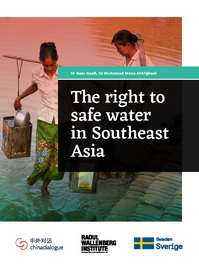Authors: Dr Mohamad Mova Al’Afghani, Dr Sam Geall
Published Date: November 2019
place of publication and publisher: Jakarta, Raoul Wallenberg Institute
Executive Summary
The human right to safe water is fundamental to leading a life with dignity. It is indivisible from, and the foundation for, achieving many other internationally recognised human rights. Yet approximately 844 million people live without access to safe water worldwide. Around 110 million of those people live in Southeast Asia (hereafter ASEAN).
Minimum requirements for safe drinking water are defined by the World Health Organization as: water that does not represent any significant risk to health over a lifetime of consumption, and that is free of microbial pathogens, chemicals and radiological substances.
Water supply should also be sufficient and continuous for individuals’ personal and domestic uses, and accessible to everyone, without discrimination. While the human right to water does not require that it be made free, water does need to be affordable.
States are duty-bound to take all necessary steps to ensure the right to safe water, including by protecting it from contamination with hazardous substances and wastes – even if a water system is privately owned.
Businesses have a corresponding responsibility to respect the right to safe water, in their products, supply chains and beyond. Information about water quality, including potential threats such as pollution, must be available and accessible. Businesses should seek to mitigate impacts on access to water, and to help ensure access to effective remedies.
In 2012, the ASEAN Human Rights Declaration explicitly guaranteed “the right to safe drinking water and sanitation”, but few ASEAN member states include the right to water in law. Many states have severe problems with water pollution. Rising stresses on the systems needed to ensure the right to safe water include: population growth, urbanisation, rapid industrialisation, and climate change – which poses disaster risks, such as cyclones and saline intrusion from sea-level rise.
In many places, water services provision is inadequate and unequal, with disparity of access between urban and rural areas. Water privatisation has, in some cases, led to poor coverage and high prices. Sanitation is also under-financed in many cases, and provided in an unequal way.
Water quality in Southeast Asia is under threat from many sectors including agriculture, manufacturing and waste management, due to insufficient wastewater treatment, chemical overuse and other factors. Mining is a particular problem, including from acid mine drainage, heavy metal contamination and leaching, processing chemicals pollution and erosion and sedimentation.
Climate change and the need for adaptation are of growing importance. Many countries in ASEAN are vulnerable to disaster risks, and exposed to sea-level rise and cyclone activity. The Himalayan glaciers are warming far faster than average, threatening the future of the Mekong and other international rivers, making transboundary water governance and large hydropower projects all the more potentially troublesome.
Deltas are particularly at risk. In the Mekong delta, for example, rice-based farming accounts for more than 65% of total freshwater demands, but water availability is increasingly threatened by complex and interrelated problems, including over-exploitation of groundwater, climate change, rising sea levels, industrial pollution, and over-use of pesticides and fertilisers.
Underpinned by government recognition and support of the right to safe water, best practices for addressing these myriad problems can include: innovative technological approaches such as solar desalination; remunicipalised water services; community-led total sanitation (CLTS); greatercircularity and efficiency in environmental management of industries like extractives; and better and adjusted investments, operations and maintenance around hydrological infrastructure, to adapt to climatic change.
See the blogpost about the report here.
